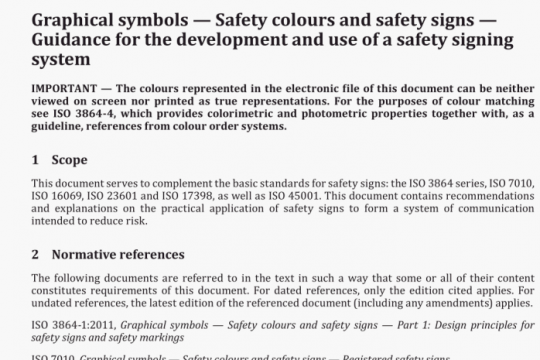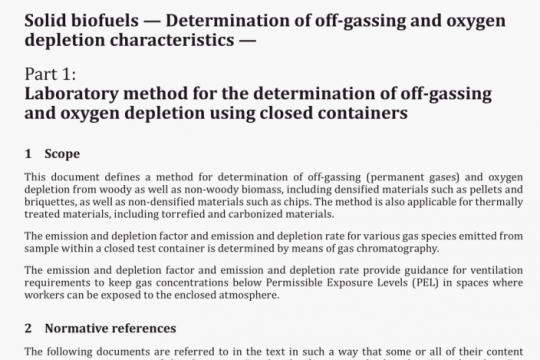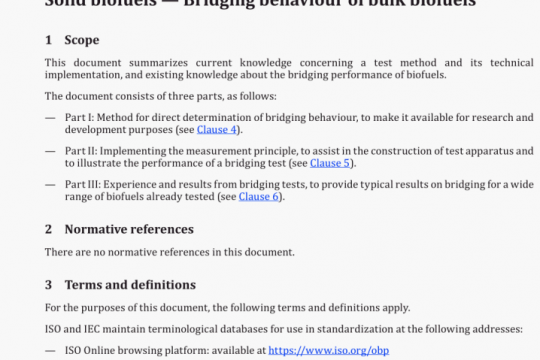ISO 22915-3 pdf free download
ISO 22915-3-2021 pdf free download.Industrial trucks – Verification of stability – Part 3: Reach and straddle trucks.
4.2.2 Tests 1,2,6,7 and 8
The truck shall be positioned on the tilt table so that its drive/steer axle, B-B. and load axle, C—C, are parallel to the tilt axis, X—Y, ofthe tilt table (see Table 1).
4.2.3 Tests34and5
The truck shall be positioned on the tilt table with the line, M—N, parallel to the tilt axis, X—Y, of the tilt table (see Table 1).
Point M is defined as follows.
a) For trucks with a single non-articulating drive (steer) wheel: point M shall be the vertical projection onto the tilt table of the point of intersection between the centreline of the drive/steer axle and the centreline ofthe drive wheel width.
b) For trucks with a non-sprung castor wheel:
1) for tests carried out on the castor wheel side of the truck, point M shall be the vertical projection onto the tilt table of the point of intersection between the centreline of the castor wheel axle and the midpoint between the castor wheel or the two castor wheels, with the non-sprung castor being positioned with the centreline of the castor wheel axle nearer to the centre plane of the truck;
for tests carried out on the drive (steer) wheel side of the truck, point M shall he the vertical projection onto the tilt table of the point of intersection between the centreline of the drive/ steer axle and the centreline of the drive wheel width.
c) For trucks with a drive/steer axle in an articulating frame articulated in the centre plane of the truck: point M shall be the vertical projection onto the tilt table of the point of the intersection between the lateral axis of the articulating frame and the centre plane, A-A, of the truck.
d) For trucks with a sprung castor wheel and a single non-sprung drive (steer) wheel: point M shall be the vertical projection onto the tilt table of the point of intersection between the centreline of the drive wheel axle and the centreline of the drive wheel width, with the axle of the drive wheel positioned at right angles to the tilt axis.
e) For trucks with non-articulated dual drive (steer) wheels in pivoting mounting: point M shall be the vertical projection onto the tilt table of the point of intersection between the centreline of the drive axle and the centreline of the width of the drive wheel closer to the tilt axis, with the axle of the drive wheels positioned at right angles to the tilt axis.
f) For trucks with non-articulated, non-sprung chassis castors: point M shall be the vertical projection onto the tilt table of the point of intersection between the centreline of the castor wheel width, with the non-sprung castor positioned with the centreline of the castor wheel axle nearer to the centre plane of the truck.
g) For trucks with a non-articulated, single-drive wheel (steered) on the centre plane, A—A, and sprung castor wheels: point M shall be the vertical projection onto the tilt table of the point of intersection between the centreline of the drive wheel axle and the centreline of the drive wheel width, with the axle of the drive wheel positioned at right angles to the tilt axis. The castor wheel closest to the tilt axis shall be positioned at right angles to the tilt axis and the castor wheel axle shall be nearer to the centre plane of the truck.
As shown in Table 1. point N is defined as the centre point of the area of contact between the tilt table surface and the load front wheel closest to the tilt axis, X—Y, of the tilt table.
4.3 Horizontal position of load datum point
Test 1 can be conducted with the horizontal position of the load datum point, E, unchanged when elevated from its lowered position as shown in Figure 2.
With the prescribed test load, set the mast vertical and then elevate to approximately 300 mm above the tilt table. With the shank of the front face of the fork arm set vertical, establish point E, as shown in Figure 2 a) and b), on the fork arms or fork carrier having a fixed relationship to the centre of gravity of the test load. Point E shall be used to provide a reference datum point, F, on the tilt table. When the mast is elevated, a new point, Fl, on the tilt table can occur, as shown in Figure 2 c) and d). This new point can be returned to the original location of F, as shown in Figure 2 e) and fJ.
For trucks with tilting masts, changes in the location of F1 can be corrected by varying the tilt of the mast within the limits provided by the design of the truck [see Figure 2 a), c) and e)].
For trucks with non-tilting masts, adjustments in the fork arms or fork carrier tilt, fork carrier retraction (where provided) or retraction of the mast may be used to correct for changes in the location of point F1, within the limits provided by the design of the truck [see Figure 2 b), d) and f)].
In North America, the location of F1 shall not be corrected. Only correction by varying the mast tilt is permissible.
4.4 Lift height for tests simulating travel
For tests simulating travel (Tests 2, 5 and 8), the upper face of the fork arms, measured at the heel of the fork arm, shall be positioned 300 mm above the tilt table.ISO 22915-3 pdf free download.




